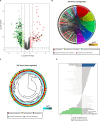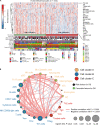Identification of an Immune-Related Prognostic Signature Associated With Immune Infiltration in Melanoma
- PMID: 33005180
- PMCID: PMC7484056
- DOI: 10.3389/fgene.2020.01002
Identification of an Immune-Related Prognostic Signature Associated With Immune Infiltration in Melanoma
Abstract
Melanoma is the leading cause of cancer-related death among skin tumors, with an increasing incidence worldwide. Few studies have effectively investigated the significance of an immune-related gene (IRG) signature for melanoma prognosis. Here, we constructed an IRGs prognostic signature using bioinformatics methods and evaluated and validated its predictive capability. Then, immune cell infiltration and tumor mutation burden (TMB) landscapes associated with this signature in melanoma were analyzed comprehensively. With the 10-IRG prognostic signature, melanoma patients in the low-risk group showed better survival with distinct features of high immune cell infiltration and TMB. Importantly, melanoma patients in this subgroup were significantly responsive to MAGE-A3 in the validation cohort. This immune-related prognostic signature is thus a reliable tool to predict melanoma prognosis; as the underlying mechanism of this signature is associated with immune infiltration and mutation burden, it might reflect the benefit of immunotherapy to patients.
Keywords: IRGs; TMB; immune cells infiltration; immunotherapy; melanoma; prognostic signature.
Copyright © 2020 Liu, Liu, Liu, Duan, Huang, Jin, Niu, Zhang and Chen.
Figures







Similar articles
-
Identification of a prognostic and therapeutic immune signature associated with hepatocellular carcinoma.Cancer Cell Int. 2021 Feb 10;21(1):98. doi: 10.1186/s12935-021-01792-4. Cancer Cell Int. 2021. PMID: 33568167 Free PMC article.
-
An immune-related prognostic signature for thyroid carcinoma to predict survival and response to immune checkpoint inhibitors.Cancer Immunol Immunother. 2022 Mar;71(3):747-759. doi: 10.1007/s00262-021-03020-4. Epub 2021 Aug 16. Cancer Immunol Immunother. 2022. PMID: 34398303 Free PMC article.
-
Exploration of a Robust and Prognostic Immune Related Gene Signature for Cervical Squamous Cell Carcinoma.Front Mol Biosci. 2021 Mar 3;8:625470. doi: 10.3389/fmolb.2021.625470. eCollection 2021. Front Mol Biosci. 2021. PMID: 33748188 Free PMC article.
-
Identification of a prognostic immune signature for cervical cancer to predict survival and response to immune checkpoint inhibitors.Oncoimmunology. 2019 Oct 3;8(12):e1659094. doi: 10.1080/2162402X.2019.1659094. eCollection 2019. Oncoimmunology. 2019. PMID: 31741756 Free PMC article.
-
Up-regulation of S100P predicts the poor long-term survival and construction of prognostic signature for survival and immunotherapy in patients with pancreatic cancer.Bioengineered. 2021 Dec;12(1):9006-9020. doi: 10.1080/21655979.2021.1992331. Bioengineered. 2021. PMID: 34654352 Free PMC article.
Cited by
-
Characterization of Aging-Related Genes to Predict Prognosis and Evaluate the Tumor Immune Microenvironment in Malignant Melanoma.J Oncol. 2022 Mar 24;2022:1271378. doi: 10.1155/2022/1271378. eCollection 2022. J Oncol. 2022. PMID: 35368886 Free PMC article.
-
Development and validation of a novel necroptosis-related gene signature for predicting prognosis and therapeutic response in Ewing sarcoma.Front Med (Lausanne). 2023 Aug 17;10:1239487. doi: 10.3389/fmed.2023.1239487. eCollection 2023. Front Med (Lausanne). 2023. PMID: 37663658 Free PMC article.
-
Construction and evaluation of an aging-associated genes-based model for pancreatic adenocarcinoma prognosis and therapies.Int J Immunopathol Pharmacol. 2023 Jan-Dec;37:3946320231172072. doi: 10.1177/03946320231172072. Int J Immunopathol Pharmacol. 2023. PMID: 37072128 Free PMC article.
-
Development and Validation of a CD8+ T Cell Infiltration-Related Signature for Melanoma Patients.Front Immunol. 2021 May 10;12:659444. doi: 10.3389/fimmu.2021.659444. eCollection 2021. Front Immunol. 2021. PMID: 34040608 Free PMC article.
-
Development of an Immune-Related Gene Signature for Prognosis in Melanoma.Front Oncol. 2021 Jan 21;10:602555. doi: 10.3389/fonc.2020.602555. eCollection 2020. Front Oncol. 2021. PMID: 33585219 Free PMC article.
References
LinkOut - more resources
Full Text Sources

